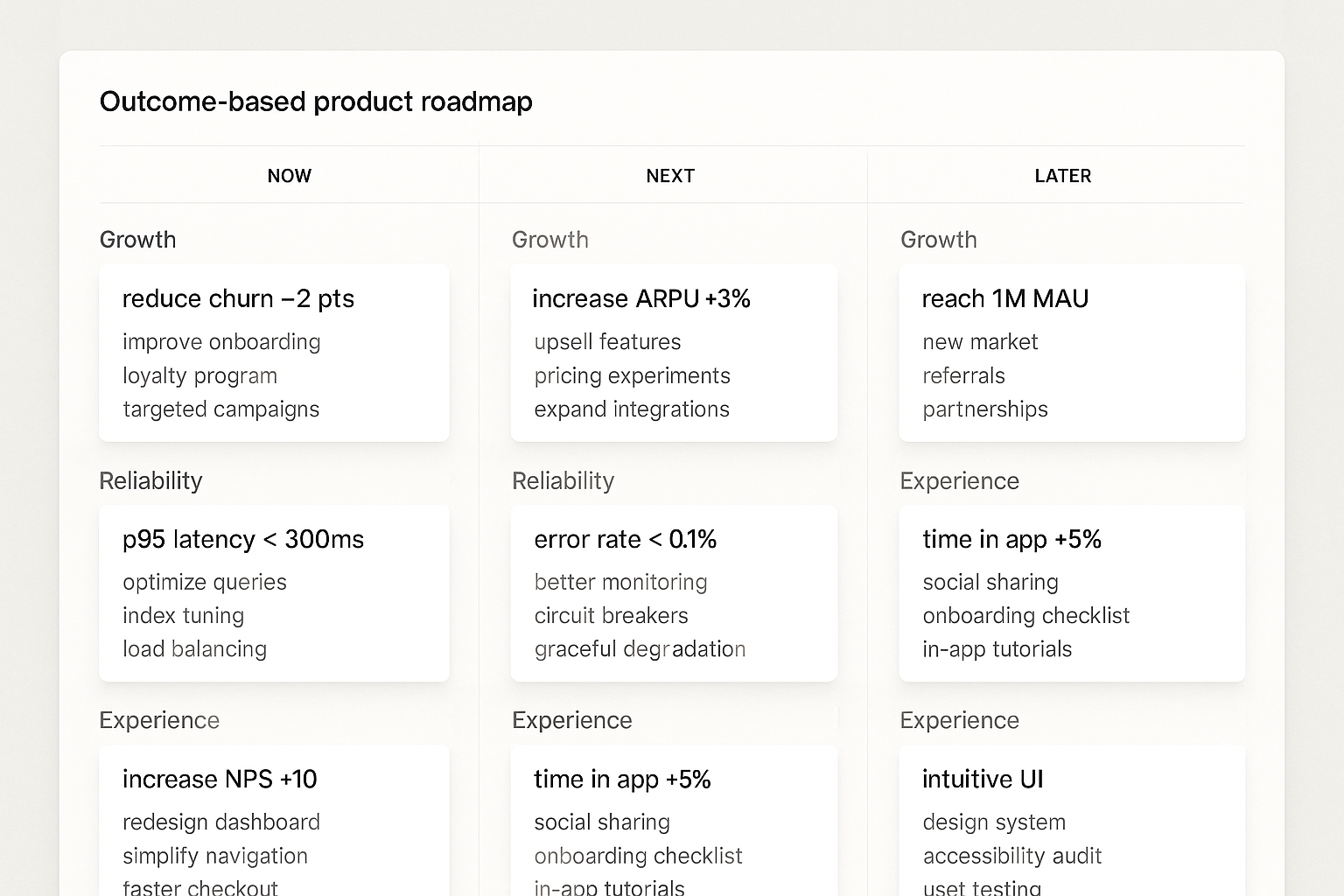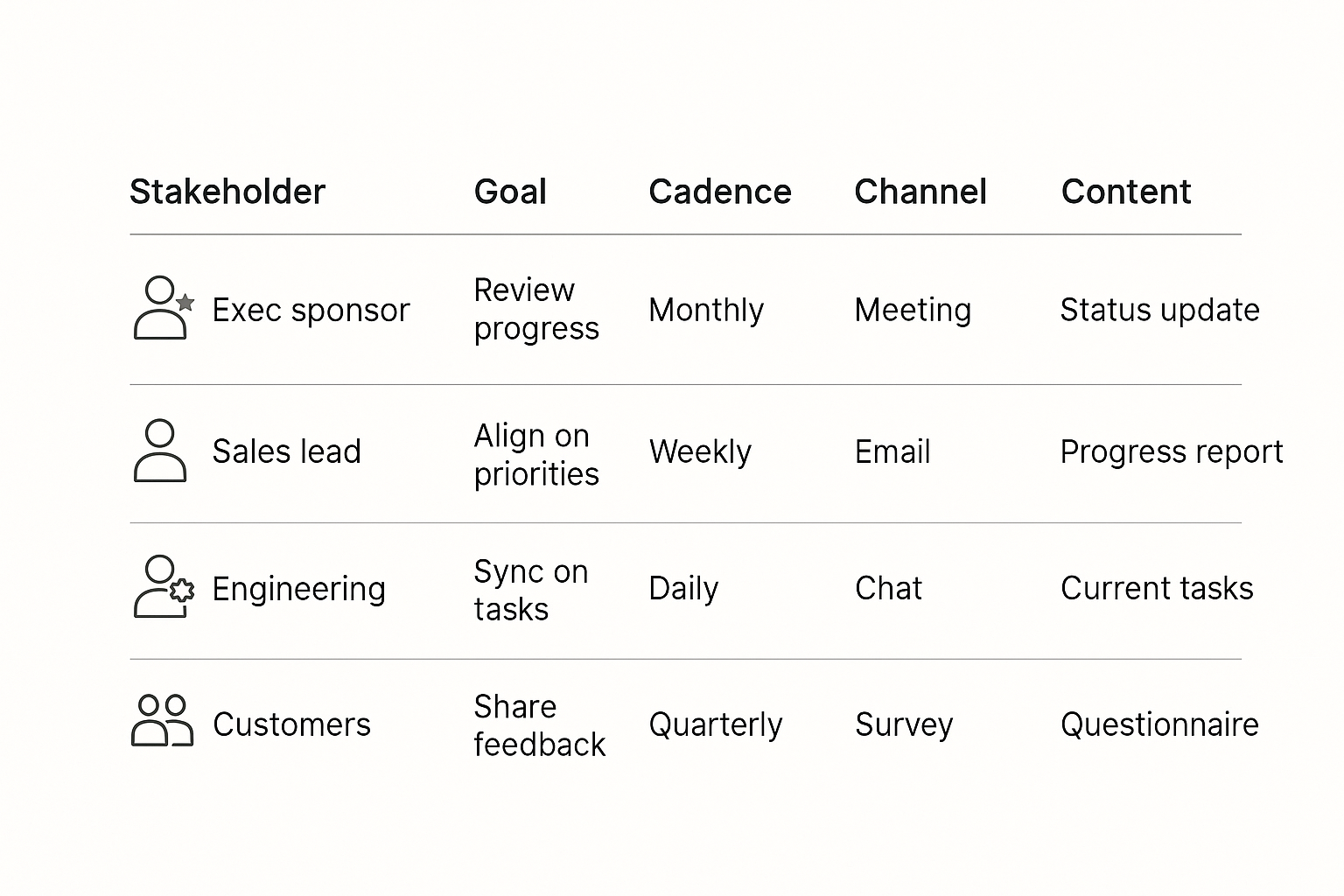# Start with outcomes, not a laundry list
A product roadmap is not a backlog in slide form. It is a clear, visual contract with your org about why you will invest, what outcomes you expect, and how you will learn along the way. Most teams still miss this. Research shows less than one third of product pros are confident their roadmaps will deliver outcomes, and nearly half struggle with vision and strategy. That gap is fixable with a few disciplined choices.
# Roadmaps are strategy in motion
When used well, roadmaps connect vision to execution. They align leaders, product, design, marketing, and engineering around a few measurable goals. They make trade-offs visible. They also invite change when the market shifts. Done poorly, they become static feature calendars that age fast and erode trust. The point is clarity and focus, not certainty.
- For leaders: tie initiatives to company goals and report progress in plain language. See the guidance on stakeholder-friendly formats from Atlassian: product roadmaps (opens new window).
- For teams: show the big picture so people can make autonomous decisions and avoid scope creep.
- For customers: share problems you plan to solve, not promises of dates.
# Roadmap vs. backlog, the line that saves you
A roadmap communicates strategy and priorities. A backlog lists work that implements the strategy. Keep them separate. ProductPlan’s overview captures this split well: what is a product roadmap (opens new window). Strategy in the roadmap, stories and defects in the backlog. When that boundary blurs, you lose both altitude and clarity.
# Shift from outputs to outcomes
Feature calendars feel comforting, then they trap you. Roman Pichler describes how feature-first plans fuel feature factories and false commitments. Outcome roadmaps avoid that by stating goals first, then options: product roadmapping mistakes to avoid (opens new window).
- State goals like reduce churn 2 points, raise activation to 40 percent, cut p95 latency to 300 ms.
- List a few candidate initiatives per goal, not exhaustive specs.
- Keep space to run experiments, then update the roadmap as you learn.

# The essential pieces of a strategic roadmap
Strong roadmaps share a simple backbone. They are easy to scan, hard to misunderstand.
- Vision and objectives: the north stars that anchor everything.
- Themes: high-level focus areas such as Growth, Reliability, Experience.
- Initiatives: bets that ladder into themes, with owners.
- Time horizons: think quarters or Now, Next, Later, not exact dates.
- Success metrics: the few KPIs that prove progress.
- Risks and dependencies: what could block you and how you will respond.
Planview’s guide covers these elements clearly, including objectives, initiatives, timelines, milestones, and resources: strategic roadmap framework (opens new window).
# Pick the right format for your context
Different moments call for different lenses. Use the form that clarifies the decision in front of you.
- Outcome or theme-based: best for strategy reviews and executive forums.
- Now-Next-Later: clean framing for evolving bets when dates are uncertain.
- Quarterly view: good for capacity and risk planning without fake precision.
- Agile or release view: short-term coordination for active delivery work.
Whatever you choose, keep the thread from initiative to outcome visible. If a card cannot name a metric, it likely does not belong.
# Earn real buy-in, then keep it
Great roadmaps secure sponsorship early and keep it through honest updates. Supportive sponsors correlate with higher delivery success. Tie your plan to company goals, and show how you will measure progress. For stakeholder-friendly structure and ongoing communication tactics, see Atlassian’s overview: product roadmaps (opens new window).
What we do in practice:
- Co-create goals with leadership, then share themes for feedback.
- Run a prioritization workshop with engineering, sales, and success.
- Publish a single source of truth, then review monthly, adjust quarterly.
# Communicate with rhythm and restraint
Standardize views and cadences so updates feel predictable, not performative. Use one roadmap, many views.
- Executive view: themes, outcomes, percent complete, key risks.
- Team view: dependencies, sequence, owners, next decision dates.
- External view: problems, benefits, what is under consideration.
A simple matrix helps keep everyone in sync. Define audience, goal, cadence, channel, content for each group.

For more on standardizing communication and status without noise, see ProductPlan’s advice on tailoring roadmap communications: communicate roadmap to stakeholders (opens new window).
# Prioritize with principles, not politics
Frameworks do not replace judgment, they focus it. Pick one or two, apply them consistently, and revisit as data arrives.
- RICE: Reach × Impact × Confidence ÷ Effort. Good when you have usage data and need comparative ranking. Quick overview here from Atlassian’s guide to prioritization.
- Value vs Complexity: Simple 2x2 that surfaces low-effort, high-value work first. Great for first pass.
- MoSCoW: Must, Should, Could, Will not. Useful for release scoping and expectation setting.
- KPI alignment: if it does not move a key metric, question why it is on the roadmap.
Productboard’s glossary summarizes these tools and their tradeoffs well: product prioritization frameworks (opens new window).
# Anti-patterns that quietly break your roadmap
Some mistakes look small, then compound.
- Feature-first planning that ignores outcomes, see Pichler’s critique above.
- Rigid dates in strategy views, use date ranges or horizons and keep exact dates in release plans.
- Overstuffed roadmaps that drive overtime, quality drops, and burnout.
- Hidden roadmaps, share role-appropriate views to build trust.
- Velocity as a KPI, treat it as a planning tool, not a scoreboard.
- Ignoring technical debt and security, make room every quarter so quality does not rot.
# A practical setup you can ship this month
Here is a lean, outcome-first setup we have used with good results:
- Three themes for the next two quarters: Growth, Reliability, Experience.
- Each theme has one to two goals, for example, reduce churn by 2 points, cut p95 latency to 300 ms, raise activation to 40 percent.
- Now-Next-Later board with two to four initiatives per theme. Each card names an owner, a leading indicator, and a first decision date.
- Quarterly review, monthly progress check, weekly delivery sync for in-flight initiatives.
- Progress signals baked in, for example, bug fixes resolved within 7 days, onboarding completion rate above 70 percent.
Small habits make this work: document trade-offs, archive prior versions, and write short decision memos when priorities change. Momentum is a product of clarity.
# Quick answers to common roadmap questions
- What is a product roadmap? A visual strategy that links goals to initiatives over time, distinct from the backlog that holds tasks.
- Should roadmaps have dates? Use quarters or Now-Next-Later for strategy. Keep exact dates in release plans.
- How often should we update it? Review monthly, adjust quarterly, and after major learnings.
- What must it include? Objectives, themes, initiatives, time horizons, metrics, risks, and owners.
- How do we get buy-in? Co-create goals, show objective prioritization, and report progress with percent complete and risks.
# The quiet rule
Quality beats speed. A good roadmap reduces noise, elevates judgment, and gives every team a shared way to say no. Build for understanding first. The outcomes will follow.